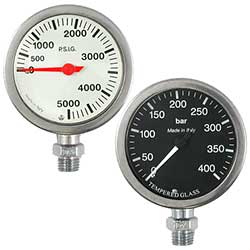The only time I've brought a tank that low was feet depth six feet from shore.
That was only because the tank needed hydro.
That was only because the tank needed hydro.
Welcome to ScubaBoard, the world's largest scuba diving community. Registration is not required to read the forums, but we encourage you to join. Joining has its benefits and enables you to participate in the discussions.
Benefits of registering include
Have you seen this happen?Most spgs lose their accuracy under 500psi from slop in the mechanism inside,
The end dive 500 psi reserve pressure rule has been discussed many times
Ending a dive with 500 psi/35 bar is different using various cylinders. With an AL80, that is 12.9 cu ft/365 l.
View attachment 797907
Obviously, your average or emergency gas consumption (RMV) will dictate the amount of gas needed for different activities. For a normal ascent from 60 ft with a 3 min safety stop at my average RMV, I need about 3 cu ft/116 psi from an AL80. For an emergency at 130 ft, a minute at the bottom, a normal ascent and a 3 min safety stop at twice my normal RMV, I need about 16 cu ft/620 psi from an AL80 (or a 19 cu ft pony)
Much of my diving is solo drift in SE FL. As I always have free access to the surface, I fairly frequently will end a dive with less than 500 psi in my AL80 if I am not limited by time. I do carry an AL19 pony. When diving in Bonaire with no real time or NDL limit, I will frequently dive my cylinder down before exiting to the shore. There are other examples where the suggested reserve pressure may not be necessary.
Yes, I would hope that you are rightI'm pretty sure that 500 PSI rule of thumb was developed for operators taking large numbers of tourists to warm water reefs using rental AL80s.
I would guess that most people who dive with their own tanks of varying size (as above) probably have enough diving experience and/or understanding to realize that the rule is to surface with a somewhat arbitrary but reasonable reserve to accommodate gear failures, injuries on the surface, entanglement, delays, etc...
You leave at 700 and rush your ascent and blow off the safety stop - all so you can reach the ladder with 500. Don't you know anything about safe diving?The issue with 500psi back on the boat is that you can't make a decision based off the information. You need to know what PSI to start your ascent at that is something you can make a decision off of. Otherwise you're just guessing. Do I need to leave at 1500psi to be back on the boat at 500, or do I need to leave at 600...
Mechanical gauge accuracy is not as precise as you think. Check out the info at the bottom of DGX page:Have you seen this happen?

